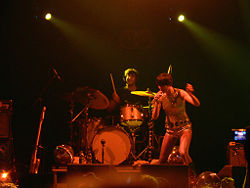Indie Music
 From Nwe
From Nwe 
In popular music, indie music (from independent) is any number of genres, scenes, subcultures, stylistic and cultural attributes characterized by its degree of independence from commercial pop music and mainstream culture and an autonomous, do-it-yourself (DIY) approach. Over the years, it has been mistaken for a musical style rather than a demarcation of status. Indie is a unique musical terms because it not only refers to label affiliation and possibly to musical style; it is attached to a system of ethics and values, like those derivative of the punk movement.
Definitions of "indie"

"Indie" was first used to differentiate between pop music and independent artists. It is based on the fact that indie artists were on independent record labels; it did not refer to the stylistic qualities of the music. "Indie" as a musical term grew from the confusion that emerged as certain sounds became associated with the term. The musical stylings of the bands overshadowed Indie's original connotation. The term "Indie" would be most effective when used as a descriptive add-on to a musical genre term, making distinctions between the musical and business aspects of music. For example: indie-rock, indie-pop, indie-rap, indie-metal, etc. Yet, indie is still widely used as a stand-alone term, resulting in a term that is broad and vague. The use of this term in America differs from its use in Britain because, in each respective region, there are completely different histories and, thus, different connotations.
"Indie" music charts have existed in the United Kingdom since the early 80s. As in America, where there are charts for Pop, R&B, Adult Contemporary, etc., Britain has the similar categories plus an independent music section. The sounds that dominated the charts, during the time of their conception in the early 80s, were guitar-based alternative music from the C86 movement, the Sarah Records' twee pop sound, and other indie pop artists. So, the sounds of the first indie artists were mistakenly understood to be the sound of indie. Yet, beyond those initial indie influences, the sounds of indie music became as wide and varied as those of the commercial market and beyond, only linked in terminology by their independent record label affiliation.
In America, indie has quite a different history. "Indie" and "alternative" were synonymous outgrowths of the post-punk and new-wave movements, which derived from the 70s punk movement. The genre that resulted was an alternative to commercial radio music and was deemed "College Rock" because of its prevalent exposure on college radio stations. When alternative rock broke out of the underground scene into the general market in the early 90s, a split occurred in the alternative scene. Two factions emerged: The artists who went to major labels and those that stayed underground. Nirvana and similar grunge bands became the commercial face of alternative rock and bands like Pavement created the aesthetic and stylistic blueprint for 90s indie rock. The artists who remained underground were called "indie" while "alternative" became the catch-all phrase to describe popular music. Once again the sound, not the commercial stance, of bands like Pavement became associated with "indie" and confusion of the term persists.
Yet, a thread that remains constant in every underground music scene is its value system. Where punk has a sound associated with its values, indie differs in that it applies punk values to every musical style imaginable.
Indie values
A do-it-yourself (DIY) sensibility, which originated with punk in the 1970s, is often associated with indie. From its beginning, punk was a movement that was created with, if not from, a set of ideals and values. There are a number of cultural and philosophical traits which could be more useful in pinpointing what "indie" means than could any specific musical or commercial trait. The concept of a "sell-out" is a value of punk rock: If an indie artist changes his or her musical style to a commercially viable sound to make more money or become famous, they are considered "sell-outs," meaning they changed their values for money. Such an indie artist would be rejected from the indie community. Issues of sincerity, authenticity, and independence are addressed in such situations.
The term "indie" represents the culture of separation from the commercial music scene. The culture of indie is what makes it distinct. Creative freedom and the DIY attitude, inherited from punk rock, make up the culture that will always stand in contrast to popular trends. Genre and label status both fail to encompass the definition of "indie." "Indie" is short for "Independent" and that attitude of independence, more than anything, determines if an artist is indie or not.
Indie vs. major labels
Creative distinctions

The word "indie" is often used to refer specifically to various genres or sounds in a realm of music that runs parallel to commercial music. During the 1980s, "indie" was synonymous in Great Britain with the jangly guitar pop of the C-86 movement. During the 1990s "indie" music became more expansive and established, as a growing number of musicians and fans began seeking alternatives to the mainstream music establishment. More recently, the word "indie" is used as a synonym for all "underground" music, similar in the way alternative was used in the 80s before it became a genre tagline for corporate, mainstream music a decade later. Such uses of "indie" are inaccurate for various reasons: For one, stylistic qualities do not correlate to commercial independence or adherence to indie principles. Secondly, the success of a subgenre could distort the supergenre's meaning, like the success of "grunge" distorted the meaning of "alternative;" the same is likely to happen to indie through one of its subgenres.
Indie and alternative have never referred to a specific musical style or sound. Yet, because of a lack of funding, a "lo-fi" (lower quality sound) aesthetic was associated with indie. Indie artists of any particular time often go against the prevailing trends. Even when better technology becomes affordable, a deliberate lack of polish and an "authentic" roughness and imperfection are sought by indie artists, especially when slick, polished recordings are the preserve of the commercial music industry. More recently, this line has become blurred in a world where high-quality recordings can be made easily with inexpensive computer-based recording systems and where commercial production teams often deliberately utilize a "lo-fi" sound.
Indie in the computer age
Artists used to be dependent on companies with capital because it was too expensive for an artist to produce and distribute an album themselves. Because of this, the musical choices offered to the public were decided by the record companies. Today, technology is finally at the point where it is affordable for an artist to produce and distribute an album without the assistance of a label.
With the arrival of new, relatively inexpensive recording devices and instruments, more individuals are able to participate in the creation of music than ever before. Studio time is extremely expensive and difficult to obtain, so most, if not all, of the newer technology is centered on the home-computer, in the form of relatively cheap hardware and software. The result of this new technology is that anyone can produce studio-quality music from their own home. Every home-made recording can be considered an indie recording. Additionally, the development of new technology allows for greater experimentation with sound since the means to do so are made widely available to the general public. After hardware and software expenses, the ambitious artist need not worry about more costs, like fees for studio space or sound engineers. As production has been made easier, distribution and advertising have also become easier because of modern advancements in technology, namely through the internet.
With the dawn of the internet, the concepts of distribution, word-of-mouth, and community have gone through ground-breaking transformations. Internet technology allows artists to introduce their music to a potentially enormous audience at low cost without necessarily affiliating with any record label. Personalized websites help artists connect more directly to their fans. Internet communities transform local-based word-of-mouth into an international network of music-listeners. Making music available to download on the internet makes distribution as easy as clicking a button.

Most artists maintain their own web sites and have a presence on sites such as Myspace.com, which has become instrumental in the success of many bands. Some sites, such as Garageband.com, rely on audience participation to rate a band, allowing listeners to have a significant impact on the success of a band. This eliminates new talent search and development, one of the most costly areas of the music business. Other sites, such as sessionsound.com, allow artists to upload their music and sell it at a price of their choosing. Visitors to the site can browse by genre, listen to free samples, view artist information, and purchase the tracks they want to buy. Technological advances such as message boards, music blogs, and social networks are also being used by independent music companies to make big advances in the business.
The design of digital music websites encourages the discovery of new music. Sites can offer large libraries of downloadable songs. This, in turn, creates many opportunities for independent bands. Digital services offer the opportunity of exposure to new fans and the possibility of increased sales through online retailers. Artists can also release music more frequently and quickly if it is made available online. Acts such as Wilco have chosen to make their new albums available for streaming before they are released. If an artist has already paid to record, manufacture, and promote their album, there is little to no additional cost for independent artists to distribute their music online. Additionally, artists have the option of releasing limited edition, out-of-print, or live material that would be too costly to produce through traditional means.
Ironically, this same technology makes it possible to easily reproduce the music and disseminate it widely, without artist label consent. The debate over whether such actions are considered "file-sharing" or "pirating" has persisted for years. Regardless, music is widely available and this availability comes with its advantages and disadvantages. This makes it increasingly difficult for an artist to make a living from albums alone. Some services like iTunes.com and BearShare.com charge a per song or monthly service fee, respectively. While being compensated monetarily is a plus, for true indie artists and labels who were never about profit to begin with, the internet revolution is the most advantageous instrument for indie culture. The computer age gives power to the grassroots movements within indie and undermines the restrictions of major labels.
Commercial distinctions
Most define indie by distinguishing major labels from independent labels. Yet, an indie purist's structural definition of "indie" would go further and distinguish big Indie labels from small Indie labels, designating the smaller labels as the true indie labels. Big Independent labels are perceived as being overly "commercial" or exploitative of certain artists or trends. The small labels are typically run by a few people and connected to a local scene; they are considered less commercially tainted and more true to the music.
Based on indie ethics, a concern for the purity of the creative mission of the label takes precedence over commercial concerns. Archetypal examples of such labels include the Sarah Records, Factory Records, Dischord, Kindercore Records, SST records and Kill Rock Stars. While major labels are economically-centered, indie labels strive for authenticity in its art. Thus, monetarily successful indie labels are somewhat rejected from purist acceptance.
This phenomenon creates an odd paradox: When indie labels become successful, they are rejected by their supporters; but the indie label is not fully accepted by the mass market either. In theory, a true indie artist would never meet any success and would write music that never gets popular. This is where a purist's ideals interfere with some of the purposes of music in general: To connect people to one another, to give people joy, to allow people to express their emotions, etc. The extreme opposite of writing successful music is writing extremely selfish music or music that no one can understand, resulting in a very pretentious attitude towards music. Yet, the point of separating from commercial music is to make sure that the purpose of creating the art remains pure. When music that is created from true purposes becomes popular, there shouldn't be any qualms about it because it achieved success the right way. Purists can be seen as the fundamentalists of indie, very extreme and hypocritical. These incidents do not so much reflect a dichotomy as it does a continuum: When indie record producers produce the music that they love, there is a chance that other people will love their music as well; potentially a lot of people.
Some labels grow from independent status and gradually become more commercially oriented (often prompted by the success of one of their acts). One example of this was Creation Records, a label Alan McGee started in the 1980s on a small scale, that gained success in the 1990s with Oasis and subsequently became more commercially oriented before being acquired by Sony. Successful indie labels most likely become subsumed by a larger conglomeration or a major label.
Major label contracts
Artists on major record labels are funded in two ways: Recoupable expenses and advances. Recoupable expenses are production (packaging and artwork), advertising, and possibly touring expenses that the artist must repay to the label, leaving the artist in debt from the beginning. Advances are like loans that take care of living and recording expenses. However, before the artists can gain any royalties from their songs, the advance must be paid back in full to the record label. Most artists see little to no royalties. Thus, an artist's desire to create good music is weighed down by the duress of having to pay a debt from the beginning. How sincere can an artist be if their motivations are fear and pressure?
In most contracts, options are agreed upon by the label and the artist: The label can opt to renew contracts or drop support for the artist. The label even holds the right to refuse distribution of an artist’s work if it is determined to be commercially or creatively unacceptable. Thus creative freedom is not as attainable because of the constraints that come from being financially supported by a major label.
Independent label contracts
Many times, a deal from an independent record label is quite similar to that of a major label. While independent labels do give advances, major label advances are generally much larger than independent labels can offer. Instead of offering an advance, some independent labels agree to pay a certain sum, which is recoup able, for recording costs. It is more common for independent labels to offer a profit-sharing deal in which as much as 40-75 percent of the net profits go to the artist. Labels that are affiliated with major labels tend to resemble those major labels. In general, independent labels that are not affiliated with a major label are more willing to take chances and are able to be more flexible in their deals.
Independent labels often rely heavily on free promotional goods: Compilations, promotional copies of albums, etc. These free materials create the buzz and word-of-mouth upon which the independent scene thrives, but artists do not receive royalties on the free merchandise; since compilation albums by independent labels are often given away, the artists receive no royalties. Major label compilations, however, are more often sold than given away, but the artist still does receive royalties.
In general, independent labels are more supportive of artists while major labels tend to focus more on the economic side of things. There are cases where major labels drop an artist to use them as a tax write-off so more money can go toward funding the label's big artists. By taking away the artist's dependency toward major labels, indie labels create outlets for more creative and sincere music. The possibility of funding is sacrificed for creative freedom.
Current indie trends

More recently, the term "indie rock" has become a catch-all phrase and so incredibly broad that almost anything from garage rock to alt-country to psychedelic folk and hundreds of other genres can fall under its umbrella.
In fact, there are likely to be several popular, and wildly varying, strains of indie rock going at any given time. For example, some of the more popular recent strains include:
- Baroque Pop, an updated take on the folk music of the 1960s, as well as the Beach Boys' pioneering Pet Sounds album, typically identified by its quiet vocals and more ornate, orchestral instrumentation and arrangements. (See: Arcade Fire, Danielson Famile, Sufjan Stevens, The Decemberists, Broken Social Scene, Islands, Stars)

- New Prog, a complex, experimental, intricate, and meticulous form of rock music. (see: Mew, Muse, Porcupine Tree)
- New Weird America or Freak Folk, a more experimental take on New Folk that generally revolves around quirky, psych-inflected folk songs and ballads. (See: Devendra Banhart, Joanna Newsom, Animal Collective, Six Organs of Admittance)
- Psych-Folk, the most heavily psych-influenced strain of New Folk, frequently consisting of avant-garde noise, drones, or dissonance, and often employing natural field recordings for added atmosphere. (See: No-Neck Blues Band, Brightblack Morning Light, Wooden Wand and the Vanishing Voice)
- Psychedelic pop, a revival of 70s psychedelic pop. (See: The Shins, Of Montreal, The Flaming Lips)
- Disco-Punk/Dance-Punk, a hybridization of New Wave music and punk rock aesthetics. (See: LCD Soundsystem, The Rapture, !!!, Out Hud, Liars, Radio 4, Death from Above 1979, Lost Sounds, The Stiletto Formal)


- Garage rock revival, a throwback to a more primitive 60s rock and roll sound which was heavily influenced by Delta blues. (See: The White Stripes, The Strokes, The Von Bondies, Eagles of Death Metal, The Vines, Yeah Yeah Yeahs, The Hives, The Black Keys)
- Twee pop, a genre which is known for simple, sweet melodies and lyrics, often with jangling guitars and a noted emphasis on childlike naivete. The name "twee" comes from the British slang for something overly sweet or knowingly cute. (See: The Boy Least Likely To, Architecture in Helsinki, Belle & Sebastian, Tullycraft, Camera Obscura, Girls in Hawaii)
- Musical collectives, where a large group of musicians—which may vary significantly from album to album, or even from song to song—collaborate on a project, often while maintaining solo careers as well. (See Broken Social Scene, The New Pornographers, Arcade Fire, The Polyphonic Spree, The Brian Jonestown Massacre, dEUS, The Hidden Cameras, Islands)
- Post-punk revival movement. Popularized by bands such as Franz Ferdinand, Arctic Monkeys, The Libertines, Dirty Pretty Things, Babyshambles, Razorlight, Editors, Bloc Party, The View, it is influenced primarily by the New Wave and post-punk movements of the 1980s. The core of this movement has mostly been the resurgence of spiky 70s punk and 80s post-punk rhythms and riffs akin to those played by The Clash, Gang Of Four, Television and Wire. Often this style has been blended with other genres such as garage rock.
References
ISBN links support NWE through referral fees
- Balling, Rich. Revolution on Canvas: Poetry from the Indie Music Scene New York: Warner, 2007. ISBN 9-780-44669-7
- Bennett, Andy and Kevin Dawe. Guitar Cultures. Oxford, NY: Berg, 2001. ISBN 0-585-43514-6
- Fonarow, Wendy, Empire of dirt: the aesthetics and rituals of British indie music, Middleton, Conn: Weslayan University Press, 2006. ISBN 0-819-56810-4
External links
All links retrieved March 2, 2018.
- Pfahl, Michael. Giving away music to make money: Independent musicians on the internet First Monday Vol 6, No 8, August 6, 2001.
- Mansfield, Brian. When Free is Profitable USA Today, May 20, 2004.
- Knab, Christopher. Deals that Await Successful Independent Music Labels April 2006.
- FreeIndie - Popular indie music website. Provides free and legal samples of albums from independent artists.
- Trouserpress - Iinfluential 1980s US-based indie publication, now an online record guide.
Credits
New World Encyclopedia writers and editors rewrote and completed the Wikipedia article in accordance with New World Encyclopedia standards. This article abides by terms of the Creative Commons CC-by-sa 3.0 License (CC-by-sa), which may be used and disseminated with proper attribution. Credit is due under the terms of this license that can reference both the New World Encyclopedia contributors and the selfless volunteer contributors of the Wikimedia Foundation. To cite this article click here for a list of acceptable citing formats.The history of earlier contributions by wikipedians is accessible to researchers here:
- Indie music history
The history of this article since it was imported to New World Encyclopedia:
- History of "Indie music"
Note: Some restrictions may apply to use of individual images which are separately licensed.
↧ Download as ZWI file | Last modified: 02/04/2023 00:47:15 | 27 views
☰ Source: https://www.newworldencyclopedia.org/entry/Indie_music | License: CC BY-SA 3.0
 ZWI signed:
ZWI signed: KSF
KSF